1840-1866
 |
Peter (Ritter v.) TUNNERProfessor |
|---|
Born 1809 in Deutschfeistritz (Styria).
1828-1830 Studies at the polytechnic institute in Vienna; followed by the administration of the Schwarzenbergischen Hammerwerke (hammer mill) in Katsch (Styria).
1835 Promotion to professorship for mining and metallurgy at the Joanneum in Graz; not yet teaching, but intense preliminaries, e.g.:
1835 – 1838 Three study trips to important mining and metallurgical plants in Western-, Northern- and Central Europe.
1840 Grand opening of the Styrian-corporative montanistic academy – montanistic academy (Steiermaerkisch-staendische montanistische Lehranstalt – Montan-Lehranstalt) in Vordernberg with Tunner as their sole professor.
1849 Promotion to director of the montanistic academy (Montan-Lehranstalt) in Leoben, Tunner exclusively applies to ferrous metallurgy (since 1849 A. Miller R. v. Hauenfels professor for mining sciences and Franz R. v. Sprung professor for metallurgy).
1864 Ennoblement: Ritter von Tunner. (Knight of Tunner)
1866 Retirement from metallurgy lectures, however still director of the mining academy in Leoben.
1874 Transfer to permanent retirement; close contact to iron industry in foreign countries (Sweden, Russia, United States of America) stay upright as well.
Died 1897 in Leoben.
Field of activity
1838 Directly after the last study trip implementation of wind heating at the furnace in Turrach through Turner – “initial spark” for many Austrian smelter works. Characterization of the likewise important rail rolling for Austria in Western Europe.
1841 First main excursion of the montanistic academy (Montan-Lehranstalt) of Vordernberg as a basis of practical-academic qualification.
1846, 1859 Narrow description of the purification process including all its variations.
since 1856 Engagement with the Bessemer process; 1863-1866 commissioning of multiple Bessemer steelworks in Austria under Tunners administration; elementary publications. Works about blister steel -, annealing-, crucible steel- and Siemens-Martin process.
1880 „Commissions-Bericht über den derzeitigen Stand der Entphosphorung des Eisens im Bessemer-Konverter nach Thomas-Gilchrist’s patentiertem Verfahren„ (with F. Kupelwieser and A. Krautner) (Commissions report about the present state of dephosphorization of iron in the Bessemer converter after the patented Thomas-Gilchrist procedure)
1858-1877 Extensive travel reports of metallurgy in Sweden (1858), in Russia (1871 and 1872) and the United States of America (1877). Publisher: „Jahrbuch für den innerösterreichischen Berg- und Hüttenmann„ (Vordernberg 1841-1847) as originator of the „Berg- und Hüttenmännischen Jahrbuches„ (1851; since 1938 „Berg- und Hüttenmännische Monatshefte„). Various awards, orders, honorary memberships etc.
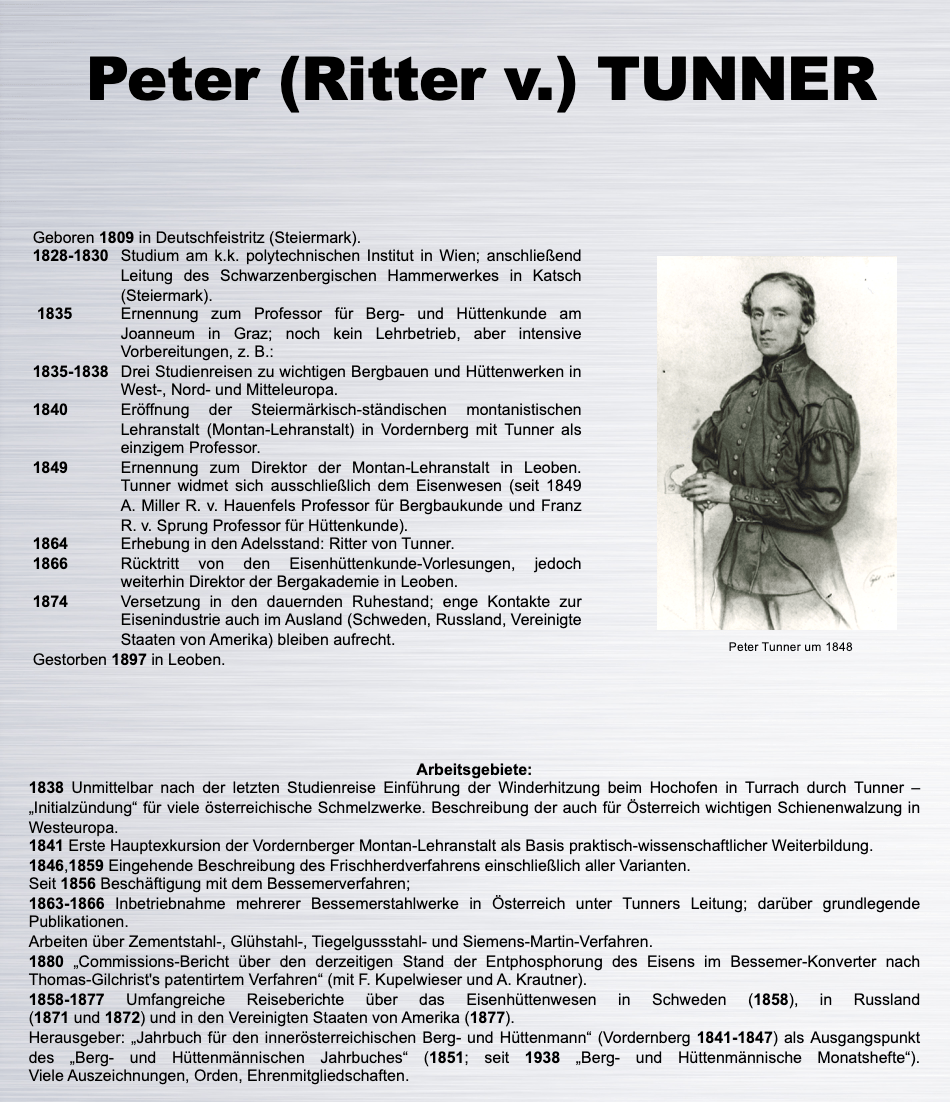
1849-1882
 |
Franz (Ritter v.) SPRUNGProfessor |
|---|
Born 1815 in Krenhof bei Köflach (Styria).
1830-1837 Natural scientific, philosophic and juridical studies at Graz; judgeship assessment in Klagenfurt.
1837-1838 Practical experience in mining- and steel works near Gmünd in Kärnten (Carinthia).
1838-1840 Studies at the k.k. mining academy (k.k. Bergakademie) in Schemnitz.
1840-1842 Studies at the montanistic academy (Montan-Lehranstalt) in Vordernberg.
1842-1849 Mining- and metallurgical administrator (Berg- und Hüttenverwalter) in Jauerburg (Krain/Slovenia).
1849 Promotion to provisional and 1854 to full professorship for metallurgy at the montanistic academy (Montan-Lehranstalt) in Vordernberg respectively Leoben.
1857 Director at the metallurgical plant Donawitz, owner: Franz Mayr (v. Melnhof) respectively from 1872 on AG der Innerberger Hauptgewerkschaft.
1881 Ennoblement: Ritter von Sprung.
1882 Transfer to permanent retirement.
Died 1890 in Graz.
Field of activity
At the montanistic academy (Montan-Lehranstalt): lectures about metallurgy including practical training and administration of main excursions.
In Donawitz:
- Improvement of welding and puddle furnaces.
- Introduction of the Siemens-Martin process (1878).
- Development of rolling mills.
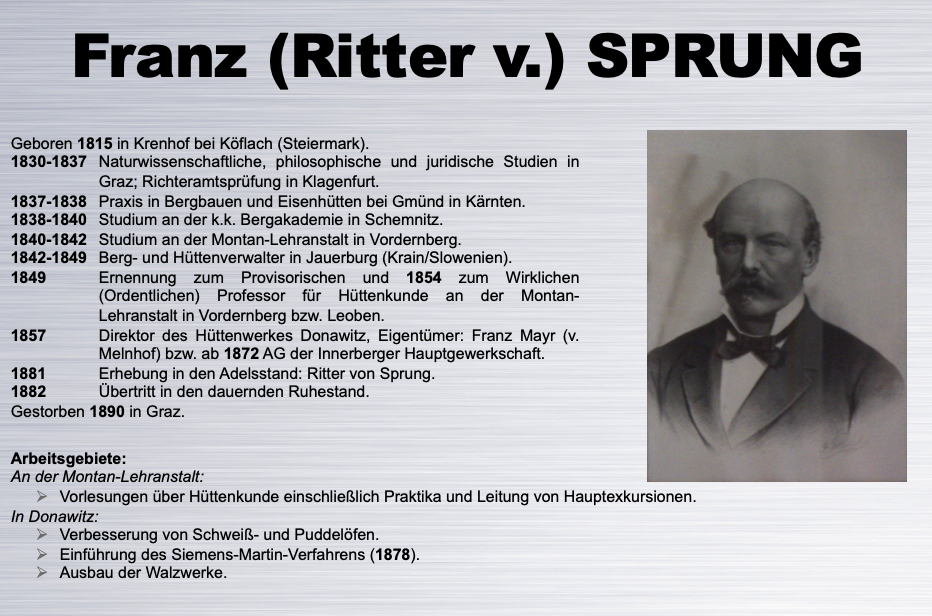
1865-1899
 |
Franz KUPELWIESERProfessor |
|---|
Born 1830 in Vienna.
1850-1852 Studies at the montanistic academy (Montan-Lehranstalt) in Leoben; afterwards assistant (k.k. Bergwesenspraktikant).
1856-1862 Leading engineer in k.k. steelwork in Reschitza (Banat).
1862-1866 (Oberhüttenmeister) chief foreman and academic for general metallurgy (Allgemeine Hüttenkunde) at the mining academy (Bergakademie) in Leoben.
1865 Promotion to full professorship for ferrous, non-ferrous metallurgy and Sudhüttenkunde in Leoben.
until 1874 Successful efforts along with director Tunner concerning the belonging of the mining academy (Bergakademie) in Leoben.
1875-1877 First director of the mining academy (Bergakademie) to be elected by the professorial council.
1895-1897 First rector elected by the professorial council of the mining academy (Bergakademie) that has been equated with the Technical Universities in 1894.
1899 Emeritus status.
Died 1903 in Pörtschach am Wörthersee (Carinthia).
Field of activity
Roasting of carbonic ore.
Furnace and production of raw iron.
- “Beiträge zum Studium des Hochofen-Processes durch directe Bestimmungen”.
- Useability of brown coal.
Metallurgical and technical questions of the Bessemer process (1864-1870).
Physical chemistry of the Siemens-Martin process and its practical accomplishment.
Studies about the Thomas process, mainly in its beginning (1879-1883).
Energy-related questions (e.g.: „Verwendung der Überhitze von Schweiß- und Puddelöfen“).
Material science of steel (e.g.: nickel-alloyed liner plates, „Mikrostruktur und Mikrophotographie“).
Reports about metallurgy at world expositions.
Detailed statistics of the production of raw iron and steel in the second half of the 19th century.
History of the mining academy (Bergakademie) Leoben 1840-1890.
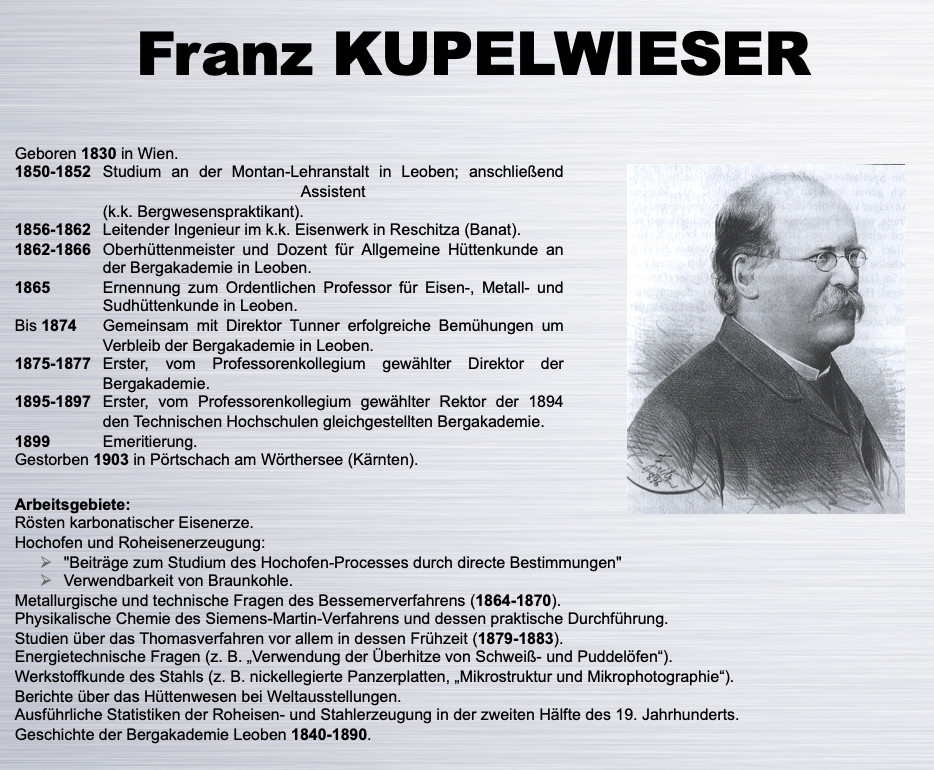
1899-1914
 |
Josef GÄNGL v. EHRENWERTHProfessor |
|---|
Born 1843 in Spittal a. d. Drau.
1862-1866 Studies at the mining academy (Bergakademie) in Leoben.
1866-1870 Relevant professional experience in steelworks in Werfen, Ebenau, Eisenerz and Storé (near Cilli).
1870-1873 Assistant at the k.k. mining academy (k.k. Bergakademie) in Pribram (metallurgy and assaying).
1873-1875 Assistant and adjunct at the mining academy (Bergakademie) in Leoben (metallurgy and assaying) until 1880.
1880 Promotion to associate professorship.
1896 Promotion to full professorship for ferrous, non-ferrous metallurgy and Sudhüttenkunde at the mining academy (Bergakademie) in Pribram.
1899 Promotion to full professorship for ferrous, non-ferrous metallurgy and Sudhüttenkunde at the mining academy (Bergakademie) in Leoben.
1881 Granting of the honorable doctorate through the University of Technology Aachen (TH Aachen) (Dr.-Ing. E. h.).
1910 Transfer to permanent retirement.
1914 Emeritus status and granting of the honorable doctorate through the Montanistic University Leoben (Montanistische Hochschule Leoben) (Dr. mont. h. c.).
Died 1921 in Klagenfurt.
Field of activity
„Darstellung von Eisen und Stahl direkt aus Erzen”. (Exposition of iron and steel out of ores)
Usage of iron ore („Erzblooms“) as oxygen carrier for the refining in Siemens-Martin furnaces of the Suedbahn-steelwork in Graz (1880 and 1882); basis for the raw iron-ore-process (Roheisen-Erz-Prozess) (with molten raw iron) established in 1893.
1879-1881/82 Direction giving publications about the metallurgy of the Thomas process and its physical-chemical-mathematical recording, e.g. 1879 „Thomas-Gilchrist’sche Verfahren des Verbessemerns phosphorreicher Roheisensorten“ and 1879/81 „Studien über den Thomas-Gichrist-Process“.
Thermotechnical issues, e.g. „Die Regenerierung der Hochofen-Gichtgase“ (1883) and „Der Wärmewert des Brennstoffes im Schachtofen und insbesondere im Eisenhochofen“ (1909/10).
Profound travel reports about ferrous metallurgy (Eisenhüttenwesen) in Sweden (1885) and in the United States of America (1895).
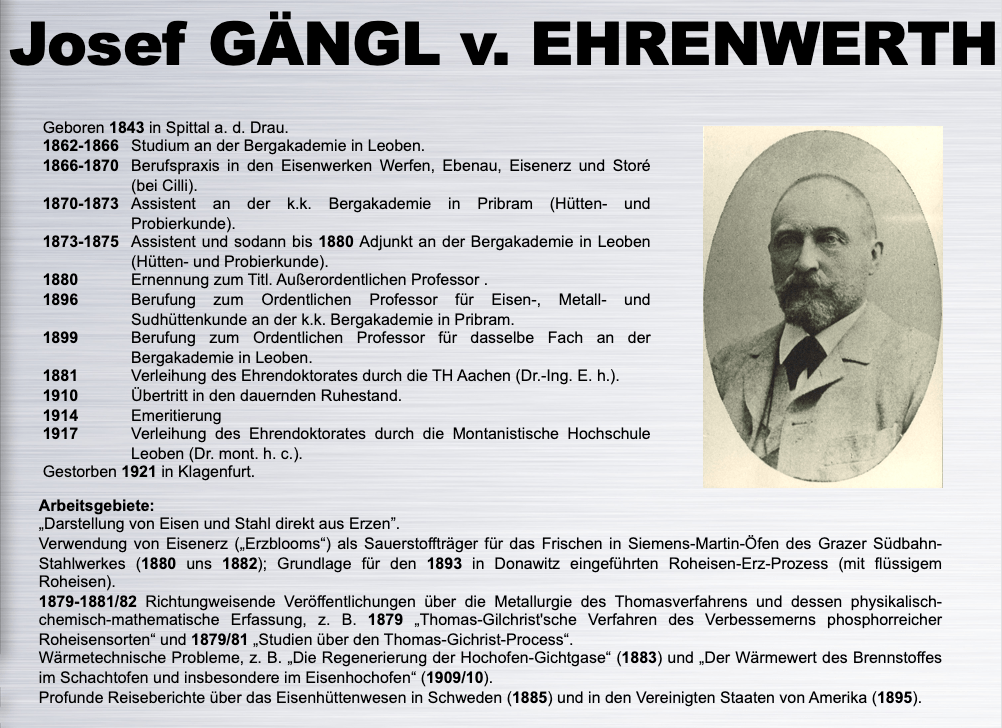
1917-1920
 |
Karl BRISKERProfessor |
|---|
Born 1875 in Königshütte (Upper Silesia, now Poland).
1896-1900 After four semesters of studying philology and history at the Universities of Prague and Berlin 1896-1900 studies of mining and metallurgy at the mining academy (Bergakademie) in Leoben; afterwards assistant for general machine engineering (Allgemeine Maschinenkunde).
1903-1905 Relevant professional experience in ironworks in Udine and Kladno.
1904 Promotion to adjunct and private lecturer for ferrous metallurgy (Eisenhüttenkunde) at the Montanistic University in Leoben (Montanistische Hochschule in Leoben).
1912; 1913 Promotion to professorship for ferrous metallurgy, substitute in this subject.
1917 Promotion to full professorship for ferrous metallurgy at the Montanistic University in Leoben (Montanistische Hochschule in Leoben).
1919-1920 Rector
Died 1920 as rector in Leoben.
Field of activity
Metallurgy of the furnace under consideration of the profile design; suggestions to the production of raw iron with electric energy.
Dephosphorization of raw iron in a (not any more realized) rotatable Siemens-Martin furnace with two hearths (simple slag change) .
Interdependence of beam properties of the microstructure and its observation in the modern metallographic microscope.
Publications:
- „Einführung in das Studium der Eisenhüttenkunde“ (1907) (An introduction to metallurgical studies), inter alia an early consideration to the Baur-Glaessner diagram regarding the furnace process.
- „Berechnung und Untersuchung des Eisenhochofens“ (1909) (Evaluation and analysis of the iron furnace) , translation into the French language.
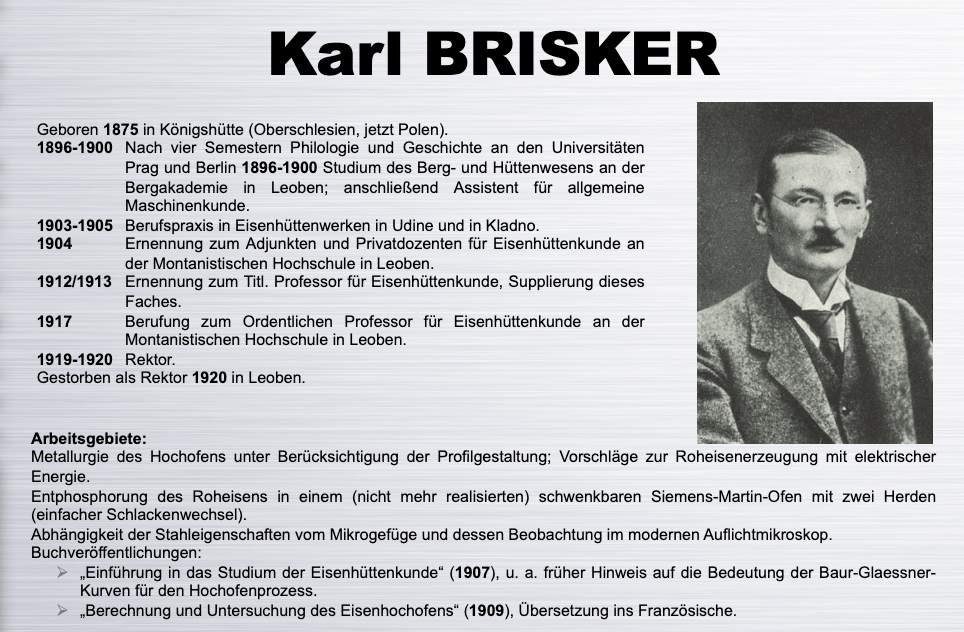
1921-1932
 |
Othmar v. KEIL-EICHENTHURNProfessor |
|---|
Born 1888 in Troppau (former Austria-Silesia).
1910-1915 Studies of ferrous metallurgy at the mining academy in Freiberg in Saxony.
1915-1916 Relevant professional experience as steelworks assistant (Stahlwerksassistent).
1916-1919 Private assistant to Professor Paul Oberhoffer (Breslau respectively Aachen).
1919 Promotion to Dr.-Ing. at the University of Technology Aachen (TH Aachen).
1920 Full-time lectureship at the Department of Ferrous Metallurgy (Eisenhüttenmännisches Institut) at the University of Technology Aachen (TH Aachen).
1921 Promotion to full professorship for ferrous metallurgy at the Montanistic University in Leoben (Montanistische Hochschule in Leoben).
1925 Foundation of the „Technisch-wissenschaftlichen Vereins Eisenhütte Österreich“ under considerable contribution of v. Keil-Eichenthurns.
Died 1932 in Graz.
Field of activity
Under the motivation of Oberhoffer dissertation about deoxidation within the Thomas process.
Modernization and development of the laboratories at the Department of Ferrous Metallurgy in Leoben (induction furnaces, heat treatment furnaces, metallographic equipment etc.).
Heat balances and analysis of the influence of different slag controls in the electric arc furnace.
Cast iron as multi component alloy
- Melting of high quality cast iron based on alloying techniques.
- Explanation and constitution of stable and metastable coagulation of cast iron.
- Inheritance of material properties.
- Wall thickness sensitivity.
- Influence of silicium on the iron-carbonate-phosphor system; influences on the graphite structure in cast iron (e.g. phosphorus content, non-metallic nucleus). Adaption by Roland Mitsche as well as Alois Legat, Hubert Pessl and Herbert Trenkler in their particular dissertation (1929 respectively 1933).
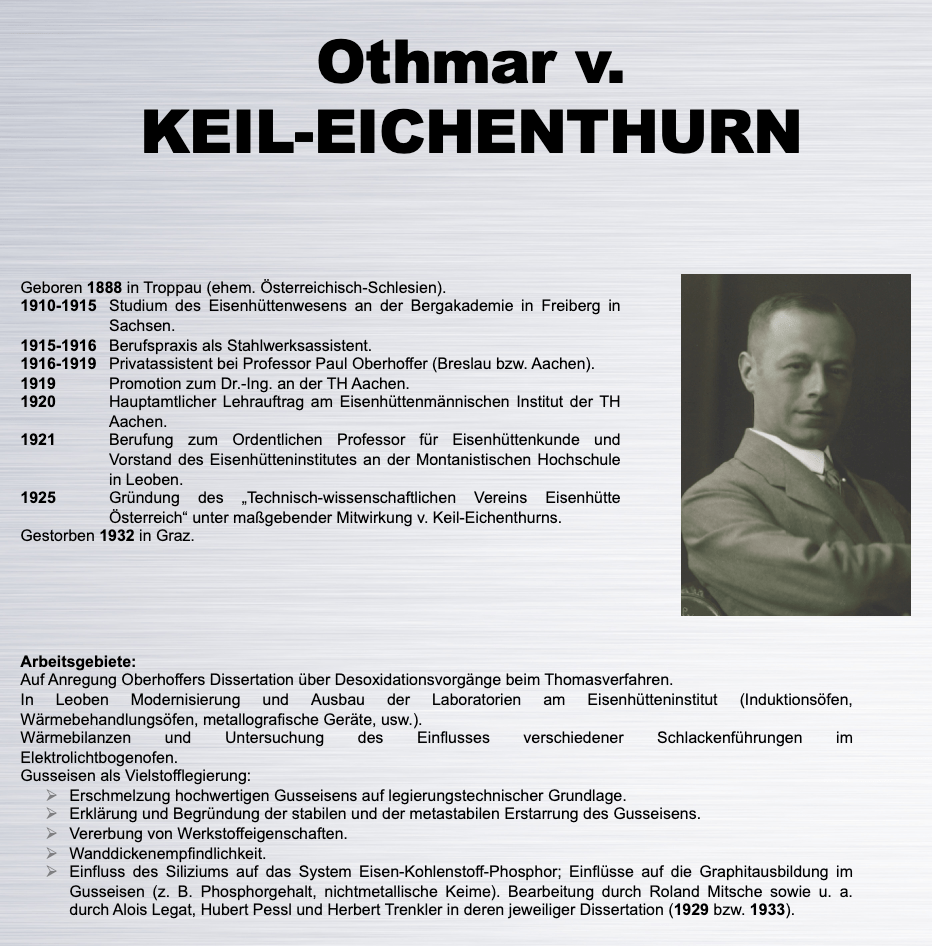
1933-1957
 |
Richard WALZELProfessor |
|---|
Born 1895 in Neunkirchen (Lower Austria).
1913-1920 Studies of metallurgy at the Montanistic University in Leoben (Montanistische Hochschule in Leoben) (1915-1918 discontinued due to military service).
1920 Admittance to the metallurgical plant Donawitz of the Österreichisch-Alpine Montangesellschaft (ÖAMG).
1926 Head and organizer of the „Stahlversuchsabteilung“.
1929 Promotion to Dr. mont. at the University in Leoben.
1933 Promotion to full professorship for ferrous metallurgy and executive board of the Department of Ferrous Metallurgy at the Montanistic University in Leoben (Montanistische Hochschule in Leoben).
1936-1937 Dean of the department of the Technical and Montanistic University Graz-Leoben in Leoben (Technische und Montanistische Hochschule Graz-Leoben).
1937-1938 Rector of the once again independent Montanistic University in Leoben (Montanistische Hochschule in Leoben).
1938 Military service (invasion of Poland), then exemption for the University in Leoben and for scientific consultation of the ÖAMG.
1950 Collaboration at the reestablishment of the „Eisenhütte Österreich“.
1954 Visiting professor at the University Manchester.
1957 Emeritus status; still consultant for certification bodies.
Died 1977 in Leoben.
Field of activity
As head of the steel testing department in charge of development tasks, e.g.:
- Quality control of the electric arc furnace which was put into operation in 1928, mainly development, inspection and practical testing of the electric mangan-steel rail (approx. 1,8% Mn) until its authorization.
- Operations to improve mechanical values of many structural steels; dissertation „Beitrag zur Kenntnis der Abhängigkeit einiger Stahleigenschaften von der Höhe des Roheisensatzes“ (1931).
At the Montanistic University continuing of the development of wear-resistant rails in collaboration with Donawitz. Reports about fundamental results at the Internationalen Schienentagungen 1935 and 1938 (e.g. core components of electric steel with 2% and 12% Mn; electrical butt-welding).
Consultant of the Brassert Oxygen Technik AG (Zuerich) in the early days of the LD process.
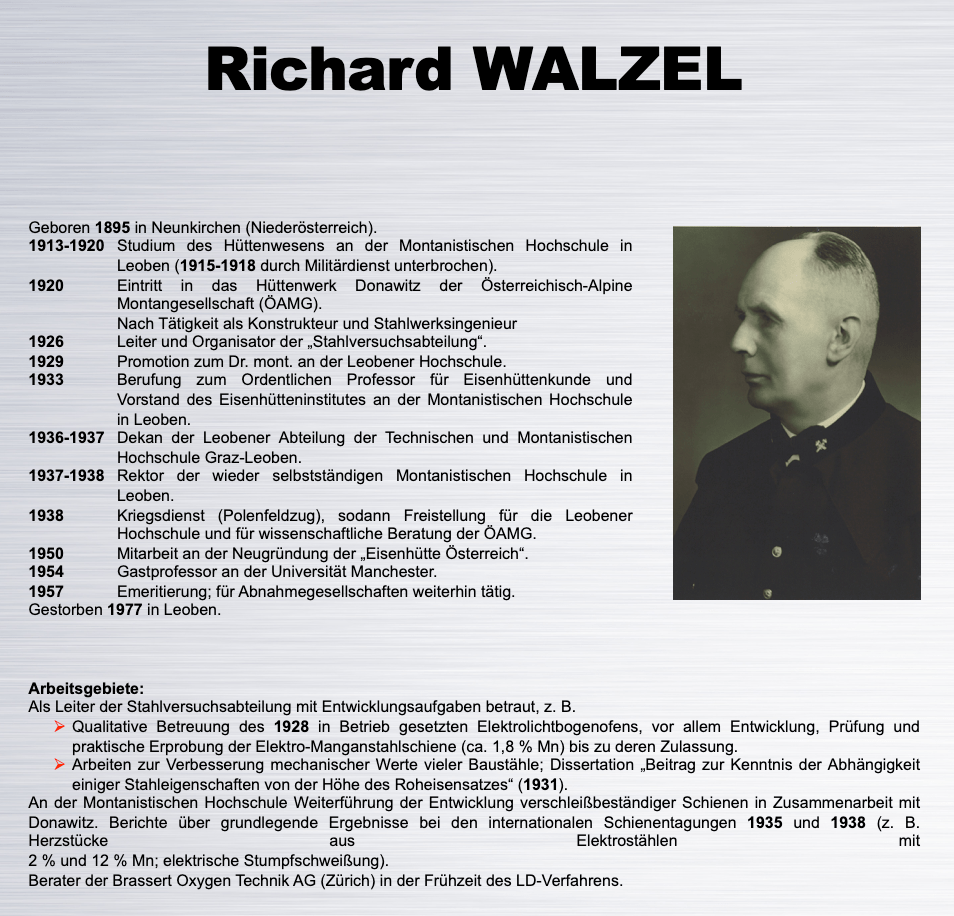
1958-1977
 |
Herbert TRENKLERProfessor |
|---|
Born 1907 in Königshof (now Czech Republic).
1926-1931 Studies of two semesters of physics at the University of Technology Muenchen (TH München) and studies of metallurgy at the Montanistic University Leoben (Montanistische Hochschule Leoben).
1933 Promotion to Dr. mont. at the Montanistic University in Leoben (Montanistische Hochschule in Leoben).
1933-1940 Relevant professional experience as steelworks assistant (Stahlwerksassistent) at Dillinger Hütte (Saarland) and at Gutehoffnungshütte in Oberhausen.
1940-1944 Head of steelwork (Stahlwerkschef) in Hagendingen (Lothringen).
1944-1945 Head (Stahlwerkschef) of “Reichswerke” in Salzgitter-Watenstedt.
1946-1948 Head of steelwork (Stahlwerkschef) in Linz (VÖEST AG).
1947 Appointment to director of the metallurgical plant.
1958 Promotion to full professorship for ferrous metallurgy and chairman of the Department of Ferrous Metallurgy at the Montanistic University in Leoben (Montanistische Hochschule in Leoben).
1958-1967 Managing director of “Eisenhütte Österreich”, then their chairman until 1978.
1962-1964 Rector of the Montanistic University in Leoben (Montanistische Hochschule in Leoben).
1972 Corresponding and 1973 full member of the Austrian Academy of Sciences (Österreichische Akademie der Wissenschaften).
1977 Emeritus status.
1978 Awarding of the Peter-Tunner Medal (Peter-Tunner-Medaille) by “Eisenhütte Österreich”.
Died 1992 in Leoben.
Field of activity
Dissertation “Beitrag zur Kenntnis der Graphitausbildung im Gußeisen, ihrer Vererbung und deren Ursachen” (1933).
As head respectively director of the steelwork in Linz:
- Decisive collaboration on the large scale development of the oxygen top-blowing process (LD) until its production maturity; 1952 commissioning of the first to be in the world LD steel plant in Linz.
- Fundamental work on blowing of high-phosphorous raw iron in the LD converter.
- Development of burner heads of pivotal 200-t-Siemens-Martin furnaces.
In cooperation with Wilfried Krieger publisher of five volumes of Gmelin-Durrer Meallurgie des Eisens:
- Volume 5: Theorie der Stahlerzeugung 1. Begriff Stahl und Möglichkeiten der Stahlerzeugung; Theoretische Grundlagen (1978).
- Volume 6: Theorie der Stahlerzeugung 2. Kinetische Grundlagen der Stahlerzeugung; Entstehung und Verhalten der nichtmetallischen Phasen im Eisenbad; Grundlagen der Erstarrung von Stahlschmelzen (1978).
- Volume 7: Practice of Steelmaking 1. Charge Materials and Additives; Sampling and Temperature Measurement; Unfired Processes (1984).
- Volume 8: Practice of Steelmaking 2. The Open Hearth Process; The Electric Arc Furnace Process; Induction Furnace Melting; New Electric Steelmaking Processes; Continuous Steelmaking (1985).
- Volume 9: Practice of Steelmaking 3. treatment of Molten Steel Outside the Melting Unit; Remelting Processes; Automatic Control of Steelmaking Processes (1988).
Principal interests of the Department of Ferrous Metallurgy:
- Viscosity behavior and structures of metals and metal alloys.
- Oxidation processes, scale behavior and scale adhesion of steel.
- Decarburisation and phase boundary reaction gas/scale/metal.
- Hot formability of steels and alloys.
Metallurgical labeling of siderite.
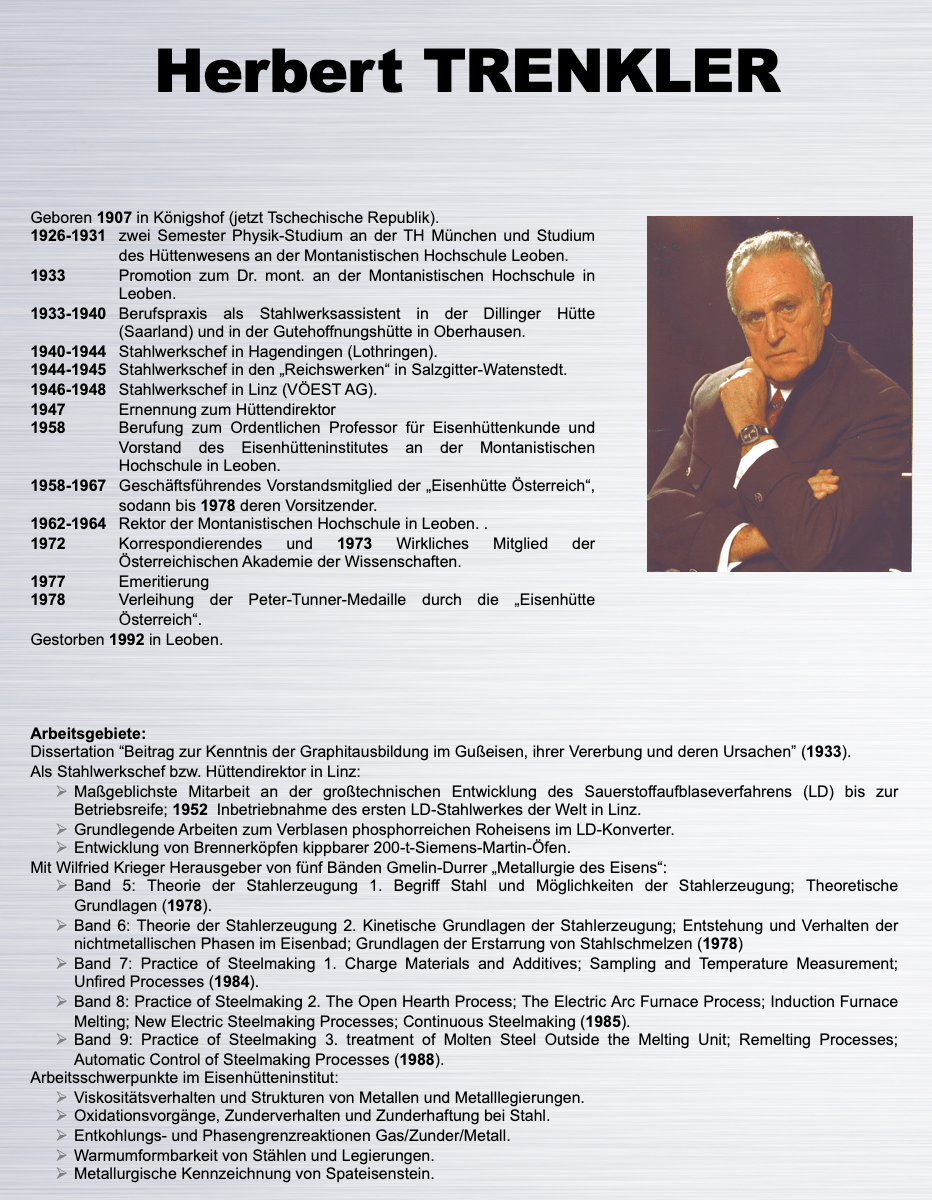
1979-2001
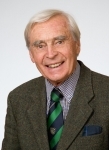 |
Herbert HIEBLERProfessor |
|---|
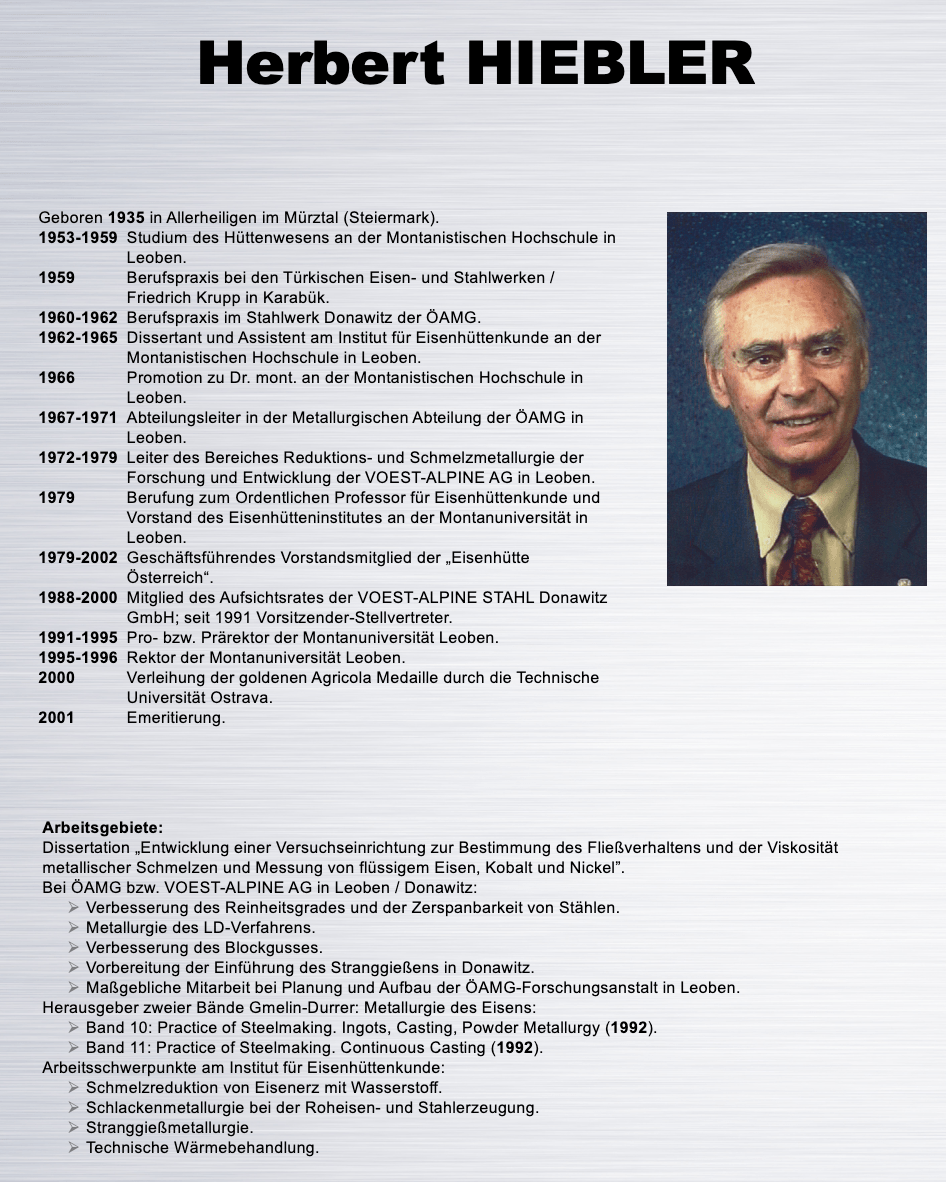
2001-2007
 |
Wilfried KRIEGERProfessor |
|---|
Born 1944 in Znaim (now Czech Republic).
1962-1968 Studies of metallurgy at the Montanistic University in Leoben (Montanistische Hochschule Leoben), then assistant at the Department of Ferrous Metallurgy.
1971 Promotion to Dr. mont. at the Montanistic University.
1971-1988 Aissistant to director in the section „Forschung, Entwicklung und Qualitätswesen“ of VÖEST AG respectively VOEST-ALPINE in Linz.
1978-1979 Lectures in ferrous metallurgy during the transition from Professor Trenkler to Professor Hiebler at the Montanistic University in Leoben (Montanuniversität in Leoben).
1988-2001 Head of the section „Forschung, Entwicklung und Qualitätswesen“ of VOEST-ALPINE AG in Linz; postdoctoral studies in blasting technology at the Montanistic University in Leoben (Montanuniversität in Leoben).
1998 Promotion to full professorship by the Austrian Federal President.
2001 Promotion to full professorship for metallurgy (Chair of Metallurgy) at the Montanistic University in Leoben (Montanuniversität in Leoben).
2004 Head of the Department of Metallurgy (chairs for metallurgy, modelling and simulation of metallurgical processes, casting research as well as thermal technology , industrial furnace construction and power/energy economics, section non-ferrous metals). Member of numerous national and international scientific bodies.
2007 Retirement.
Died 2009 in Linz.
Field of activity
Dissertation „Viskositätsverhalten von Legierungsschmelzen auf Eisenbasis” (1971).
Post doctoral thesis „Metallurgie und Technologie der Stahlerzeugung“ (1988).
In cooperation with Herbert Trenkler publisher of five volumes of Gmelin-Durrer Meallurgie des Eisens:
- Volume 5: Theorie der Stahlerzeugung 1. Begriff Stahl und Möglichkeiten der Stahlerzeugung; Theoretische Grundlagen (1978).
- Volume 6: Theorie der Stahlerzeugung 2. Kinetische Grundlagen der Stahlerzeugung; Entstehung und Verhalten der nichtmetallischen Phasen im Eisenbad; Grundlagen der Erstarrung von Stahlschmelzen (1978).
- Volume 7: Practice of Steelmaking 1. Charge Materials and Additives; Sampling and Temperature Measurement; Unfired Processes (1984).
- Volume 8: Practice of Steelmaking 2. The Open Hearth Process; The Electric Arc Furnace Process; Induction Furnace Melting; New Electric Steelmaking Processes; Continuous Steelmaking (1985).
- Volume 9: Practice of Steelmaking 3. treatment of Molten Steel Outside the Melting Unit; Remelting Processes; Automatic Control of Steelmaking Processes (1988).
Working focus in the Department of Ferrous Metallurgy:
- Reduction/smelting reduction.
- Steel and alloy development.
- Interaction steel/slag.
- Non-metallic inclusions.
- Continuous casting.
Remelting technology.

Since 2008
 |
Johannes SCHENKProfessor |
|---|
Born 1958 in Klagenfurt (capital city of Carinthia, Austria)
1973 – 1978 Technical High School in Klagenfurt, Austria
1979 – 1985 Study of Process Engineering on Graz Univ. of Technology, Austria
1985 – 1989 Doctor Thesis on Graz Univ. of Technology
1988 – 1990 Assistant Professor on Graz Univ. of Technology
1990 – 2008 Employee of Siemens VAI Metals Technologies GmbH, Linz, Austria, former VOEST ALPINE Industrieanlagenbau (VAI)
1990 – 1993 Process Engineering for Direct and Smelting Reduction (MIDREX, COREX)
1993 – 2008 General Manager and Vice President for Research and Development of new Reduction Technologies (FINEX, COREX, FINMET)
1993 – 2003 Head of R&D for joint FINEX technology development of Siemens VAI and POSCO, Korea
2004 – 2008 Project Manager for first commercial FINEX plant, Korea (FINEX 1.5 M)
Since Oct. 08 Full Professor at Chair of Ferrous Metallurgy and Head of Department of Metallurgy at Montanuniversitaet Leoben
Since June 15 Chief Scientific Officer of K1-Met GmbH
Awards and Achievements
- Corporate Award of Siemens “Inventor of the Year 2006”
- Co-Inventor of the patent nominated for the “European Inventor Award 2013” in the category Non-European countries
Affiliations
- Editor in Chief of Technical Journal “Berg- und Hüttenmännische Monatshefte”
- Member of Advisory Board of Technical Journal “Steel Research International”
- Member of the Senat of the “Christian Doppler Forschungsgesellschaft”, Austria
- Head of sub-committee of experts for “Physical Chemistry and Metallurgical Process Development” of Steel Institute VDEH, Germany
Publications and patents
- Author and co-author of 125 publications and contributions to conferences from 1987 to 2014
- Co-inventor of more than 30 patent families (total more than 400 patents applied worldwide)
Personnel skills and competences
- Research and teaching in metallurgy for iron and steelmaking,
- Expertise in fluid dynamics and reaction kinetics for heterogeneous reactor systems (gas-solid-liquid systems)
- Project management for R&D and commercial projects


